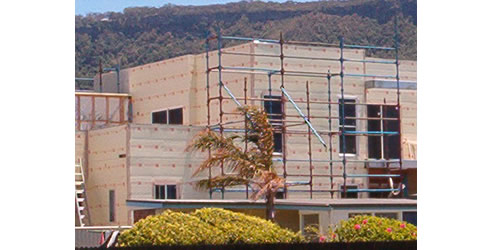Foamular Extruded Polystyrene & Expanded Polystyrene differences by Austech Austech Investigates The Differences Between Foamular Extruded Polystyrene & Expanded Polystyrene. There is often a great deal of confusion between expanded (EPS) and extruded polystyrene(XPS), with many people assuming they are essentially the same, but in fact expanded and extruded polystyrene are very different products. Firstly there is the manufacturing procedure involved in creating the product. Expanded Polystyrene (EPS) is made using small expandable beads that inflate with heat, and then are placed into a mould, where they expand to fit the shape. The expanded beads trap air, which gives expanded polystyrene its insulation properties, but also leaves it venerable to water absorption, reducing the insulations effectiveness over time. Extruded Polystyrene (XPS) is made by mixing polystyrene pellets with chemicals that liquefy the pellets. A blowing agent is then injected into the mixture, forming billions of miniature air pockets. This frothing mixture is then pushed through a shaping die to give the required size and minimise wastage. Once cooled the boards can be further shaped and wastage returned into the manufacturing process. Foamular Extruded Polystyrene is manufactured by Owens Corning Asia Pacific. Owens Corning has developed a patented Hydrovac technology that makes the blowing agent more efficient and helps guarantee long term retention of R-values. Owens Corning is a member of EPA Climate Leaders Program, and is committed to reducing Greenhouse Gas Emissions in the manufacturing process through product performance. Extruded Polystyrene's unique production process gives it superior R-value in comparison to expanded polystyrene and many other building materials. This improved effectiveness helps reduce temperature fluctuations and improve energy efficiency for the entire product lifecycle. R Values of some common building materials:
Foamular metric XPS 250 /50mm = R1.78 Compressive strength is another key advantage for Foamular Extruded polystyrene, since it can be used for high pressure applications, such as under slab insulation and in PRMA roofing applications. This structural rigidity also improves the products lifecycle, for instance when Foamular is used as a render substrate, its improved impact resistance and structural strength helps reduce future damage and cracks to the render. Foamular Extruded Polystyrene's closed cell structure stops water absorption, which is a leading cause of loss in R-value in other forms of insulation. Expanded polystyrene does not have a closed cell structure and easily absorbs water, dramatically reducing its thermal properties and its overall structural integrity. Overall Foamular Extruded Polystyrene from Owens Corning outperforms expanded polystyrene (EPS)in the three key areas of R-value, moisture resistance and compressive strength, making Foamular a more efficient and durable insulation product.
|
Austech External Building Products Profile 02 9831 1623 27 Prince William Drive, Seven Hills NSW 2147
|



 Wall Panel with Stone Wool Core by
Wall Panel with Stone Wool Core by Insulation Board for Soffits by Austech
Insulation Board for Soffits by Austech Insulation for Waterproofed Flat Roofs
Insulation for Waterproofed Flat Roofs Roof Sarking For Masonry Tiles and Metal
Roof Sarking For Masonry Tiles and Metal Window Flashing Tape by Austech
Window Flashing Tape by Austech Acoustic Absorption Blanket for
Acoustic Absorption Blanket for Synthetic Wrap for Walls by Austech
Synthetic Wrap for Walls by Austech Board & Batten Siding from Austech
Board & Batten Siding from Austech Model Making Foam by Austech
Model Making Foam by Austech Insulation for Floors by Austech
Insulation for Floors by Austech Flame Retardant Insulated Wall Panel by
Flame Retardant Insulated Wall Panel by Reflective Insulation Ceiling and Wall
Reflective Insulation Ceiling and Wall Natural Stone and Concrete Sealer by
Natural Stone and Concrete Sealer by Water Resistant Wall Wrap by Austech
Water Resistant Wall Wrap by Austech Rigid Foam Insulation for Wine Cellars
Rigid Foam Insulation for Wine Cellars Timber Design Aluminium Siding by
Timber Design Aluminium Siding by Duratuff Select Vinyl Cladding from
Duratuff Select Vinyl Cladding from Energy Efficient Insulated Wall Panel by
Energy Efficient Insulated Wall Panel by Recyclable Aluminium Cladding for Homes
Recyclable Aluminium Cladding for Homes Solid Aluminium Rainscreen Facade by
Solid Aluminium Rainscreen Facade by
